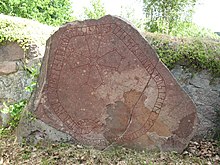Runestones on the Arja ödekyrka
The rune stones at Ärja ödekyrka (Sö 335 and Sö 333 or Åker 137: 1 and 137: 2) are located southeast of Åker near Strängnäs in Södermanland in Sweden . The rune stone Sö 334, which was moved to Mariefreds kyrka, was also located here.
Runestone Sö 335
The rune stone Sö 335 was found in 1919 during excavations at the Arja kyrkoruin (church ruins of Arja), where it was a threshold at the entrance to the vestibule. After standing on Lida Farm for a few years, it was returned to the ruins in 1932. The stone, about 1.5 m high, 1.9 m wide and 0.1 to 0.15 m thick, is made of red-black granite . The stone has two cracks. The incision with a relatively simple but harmonious ornament is well preserved. The serpentine ribbon follows the pentagonal shape of the stone. The central ring cross is stylistically unusual. The text reads: "Ulf built this stone after his brother Osniken, who died in the east with Ingvar (he was) Holmsten's shipmate."
The runologist Erik Brate (1857–1924) believes that the Holmsten mentioned on the stone is the man mentioned on one of the rune stones from Tystberga (Sö 173). If that's true, Osniken was a fighter on the ship that Holmsten owned. Skipper can also mean that Osniken owned a ship in Ingvar's fleet, but the runologists don't believe this. The first name is uncertain because of a strange tie between f and u. E. Brate suggested the feminine name Ulfvi, but UlfR or Ulfviðr is more likely.
This is one of the 26 Ingvar stones . You can clearly see the lettering Ikuari (for Ingvar). As with other Ingvar stones, the same construction of the inscription can be seen here, where "Ingvar" stands a little on its own and always has a central position on the stone. Ingvar Vittfarne ( German "Ingvar the far-traveled " , also Ingvar Emundsson) undertook a war trip ( Swedish útrór ) to Serkland on the Caspian Sea , in which he and many of his people died. After six years, only one of 30 ships returned to the Mälaren in 1042 AD . Archaeologist Mats G. Larsson claims that Ingvar came from a large farm nearby.
Runestone Sö 333
The rune stone Sö 333 is first mentioned in the reports of Johan Peringskiöld (1654–1720) about his travels in the years 1684–1686. He states that the church was already abandoned and then destroyed.
The rune stone, about 1.5 m high and 0.7 m wide at the base, tapers upwards, is 0.4 m thick and made of red-black granite. The rune height is 7.0 to 8.0 cm. The inscription is dated from 1010 to 1050. The text reads: “Amunde built this stone after his son Runulv and (after) Ring, his brother. He was killed in Kalmarsund in Skåne . Eskil cut the runes ”.
The serpentine ribbon runs from the lower center along the edges of the stone and ends in the upper center. The name of the rune master ( Swedish runmästare ) Eskil is inside a snake. The stone lacks the Christian cross. The runes tell of a murder or manslaughter that happened in Kalmar Strait in Skåne . Because of this tragic event, two place names were first recorded in writing.
literature
- Ingegerd Wachtmeister, Thorgunn Snaedal Brink: Runstenar i Södermanland , Södermanlands museum, 1984, ISBN 91-85066-52-4 .
Web links
- Description Swedish and picture
- Description Swedish and picture
- Description Swedish and picture
- Description Swedish and picture
Coordinates: 59 ° 16 '26 " N , 17 ° 7' 54.6" E


